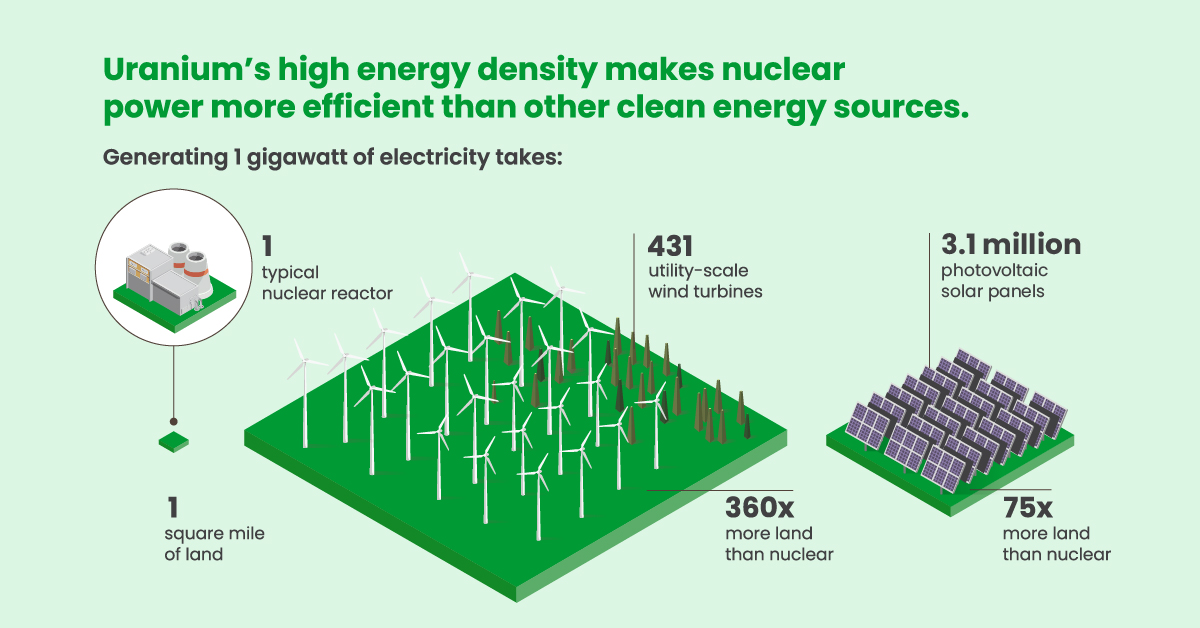Smashing Atoms: The History of Uranium and Nuclear Power
The following content is sponsored by the Sprott Physical Uranium Trust

The History of Uranium and Nuclear Power
Uranium has been around for millennia, but we only recently began to understand its unique properties.
Today, the radioactive metal fuels hundreds of nuclear reactors, enabling carbon-free energy generation across the globe. But how did uranium and nuclear power come to be?
The above infographic from the Sprott Physical Uranium Trust outlines the history of nuclear energy and highlights the role of uranium in producing clean energy.
From Discovery to Fission: Uncovering Uranium
Just like all matter, the history of uranium and nuclear energy can be traced back to the atom.
Martin Klaproth, a German chemist, first discovered uranium in 1789 by extracting it from a mineral called “pitchblende”. He named uranium after the then newly discovered planet, Uranus. But the history of nuclear power really began in 1895 when German engineer Wilhelm Röntgen discovered X-rays and radiation, kicking off a series of experiments and discoveries—including that of radioactivity.
In 1905, Albert Einstein set the stage for nuclear power with his famous theory relating mass and energy, E = mc2. Roughly 35 years later, Otto Hahn and Fritz Strassman confirmed his theory by firing neutrons into uranium atoms, which yielded elements lighter than uranium. According to Einstein’s theory, the mass lost during the reaction changed into energy. This demonstrated that fission—the splitting of one atom into lighter elements—had occurred.
“Nuclear energy is incomparably greater than the molecular energy which we use today.”
—Winston Churchill, 1955.
Following the discovery of fission, scientists worked to develop a self-sustaining nuclear chain reaction. In 1939, a team of French scientists led by Frédéric Joliot-Curie demonstrated that fission can cause a chain reaction and filed the first patent on nuclear reactors.
Later in 1942, a group of scientists led by Enrico Fermi and Leo Szilard set off the first nuclear chain reaction through the Chicago Pile-1. Interestingly, they built this makeshift reactor using graphite bricks on an abandoned squash court in the University of Chicago.
These experiments proved that uranium could produce energy through fission. However, the first peaceful use of nuclear fission did not come until 1951, when Experimental Breeder Reactor I (EBR-1) in Idaho generated the first electricity sourced from nuclear power.
The Power of the Atom: Nuclear Power and Clean Energy
Nuclear reactors harness uranium’s properties to generate energy without any greenhouse gas emissions. While uranium’s radioactivity makes it unique, it has three other properties that stand out:
- Material Density: Uranium has a density of 19.1g/cm3, making it one of the densest metals on Earth. For reference, it is nearly as heavy (and dense) as gold.
- Abundance: At 2.8 parts per million, uranium is approximately 700 times more abundant than gold, and 37 times more abundant than silver.
- Energy Density: Uranium is extremely energy-dense. A one-inch tall uranium pellet contains the same amount of energy as 120 gallons of oil.
Thanks to its high energy density, the use of uranium fuel makes nuclear power more efficient than other energy sources. This includes renewables like wind and solar, which typically require much more land (and more units) to generate the same amount of electricity as a single nuclear reactor.
But nuclear power offers more than just a smaller land footprint. It’s also one of the cleanest and most reliable energy sources available today, poised to play a major role in the energy transition.
The Future of Uranium and Nuclear Power
Although nuclear power is often left out of the clean energy conversation, the ongoing energy crisis has brought it back into focus.
Several countries are going nuclear in a bid to reduce reliance on fossil fuels while building reliable energy grids. For example, nuclear power is expected to play a prominent role in the UK’s plan to reach net-zero carbon emissions by 2050. Furthermore, Japan recently approved restarts at three of its nuclear reactors after initially phasing out nuclear power following the Fukushima accident.
The resurgence of nuclear power, in addition to reactors that are already under construction, will likely lead to higher demand for uranium—especially as the world embraces clean energy.
-

 Sponsored3 years ago
Sponsored3 years agoMore Than Precious: Silver’s Role in the New Energy Era (Part 3 of 3)
Long known as a precious metal, silver in solar and EV technologies will redefine its role and importance to a greener economy.
-

 Sponsored7 years ago
Sponsored7 years agoThe History and Evolution of the Video Games Market
Everything from Pong to the rise of mobile gaming and AR/VR. Learn about the $100 billion video games market in this giant infographic.
-

 Sponsored8 years ago
Sponsored8 years agoThe Extraordinary Raw Materials in an iPhone 6s
Over 700 million iPhones have now been sold, but the iPhone would not exist if it were not for the raw materials that make the technology...
-

 Sponsored8 years ago
Sponsored8 years agoThe Industrial Internet, and How It’s Revolutionizing Mining
The convergence of the global industrial sector with big data and the internet of things, or the Industrial Internet, will revolutionize how mining works.

